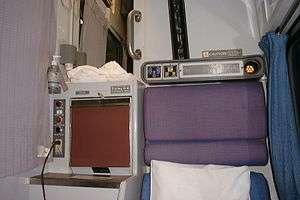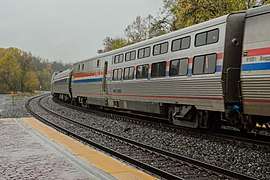Viewliner
The Viewliner is a single-level railway car type used by Amtrak on most long-distance routes operating east of Chicago. The first production cars, consisting of an order of 50 sleeping cars, were put into service in 1994. On March 23, 2015, Amtrak began putting 70 new Viewliner II baggage cars into service, and delivered the final car in 2016. The new baggage cars are used on all Amtrak trains with full baggage cars, single-level and bi-level. They replaced all of the Heritage Fleet baggage cars that Amtrak inherited from the freight railroads when it was created in 1971. The first of the 25 Viewliner II dining cars entered service in late December 2016, and the last was delivered in February 2019. Four of the 10 baggage-dorms are in service (on the Crescent), and one of the 25 sleepers have been delivered (without entering service).
| Viewliner | |
|---|---|
Viewliner I #62019 on the Lake Shore Limited in Boston. | |
 A seat in a Viewliner I roomette. | |
| Manufacturer | Budd Company (prototypes) Morrison-Knudsen (Viewliner I) CAF (Viewliner II) |
| Constructed |
|
| Entered service | 1988–present |
| Number under construction | 130 (Viewliner II) |
| Number built | 3 (Prototypes) 50 (Viewliner I) 100 (Viewliner II) |
| Number in service | 145 |
| Fleet numbers | Prototypes: 2300, 8400, 10004
Viewliner I: 62000-62049 Viewliner II: 61000-61069, 62500-62524, 68000-68024, 69000-69009 |
| Capacity | 30 |
| Operator(s) | Amtrak |
| Specifications | |
| Car body construction | Stainless Steel |
| Car length | 85 feet (25.91 m) |
| Width | 10.5 feet (3.20 m) |
| Height | 14 feet (4.27 m) |
| Floor height | 4 ft (1.2 m) |
| Platform height | 4 ft (1.2 m) |
| Maximum speed | 110 mph (177 km/h) (Prototypes/Viewliner I) 125 mph (201 km/h) (Viewliner II) |
| Power supply | 480 V AC 60 Hz |
| Bogies | GSI 70 |
| Braking system(s) | Air |
| Coupling system | AAR |
| Track gauge | 4 ft 8 1⁄2 in (1,435 mm) standard gauge |
Early design

In the 1980s, Amtrak was looking to replace its Heritage Fleet railcars, which had been in service as far back as the 1940s. While new Superliner cars were built starting in 1979, those cars were too tall to run on Amtrak's eastern routes because of clearance issues in and around both New York Pennsylvania Station and Baltimore Pennsylvania Station (see loading gauge and structure gauge).
Working with the Budd Company, Amtrak drafted plans for new single-level sleeping and dining cars that utilized a 'modular' design where the interiors of the cars, especially the sleepers, were built in units separate from the exterior shell. These units contain all fixtures, electrical components, sewage and fresh water handling internally and are then mated with the car exterior shell upon assembly. This approach allows for easier maintenance and reconfiguration through removal and replacement of individual units. Access for this purpose is via a removable hatch on the side of the car, a distinguishing feature of the Viewliner series. Unlike the Superliners, occupants of both bunks in the bedrooms have an outside view. The design of the cars was created by Amtrak's design group, which received input from every department in the company. At the time of their introduction into service, Amtrak planned to assemble a fleet of over a thousand cars during the ten years after their introduction.[1]
The prototype Viewliner cars were assembled at Amtrak's Beech Grove Shops in Beech Grove, Indiana in 1987-1988 from Budd components. Two sleeping cars (2300 and 2301) were built, as was one dining car (8400). These cars were tested on the Capitol Limited beginning in 1988.[2] One of the Viewliners was also tested on the Auto-Train.[3] The prototypes were in regular service until 2002; however, money from the 2009 stimulus package funded the restoration of dining car 8400 to regular service.[4]
In March 2014,[5] prototype sleeper 2301 (which had been renumbered to 62091)[6] was converted into an inspection car[7] named "American View"[8] and given the number 10004. This inspection car has rear-facing seats and a large glass window at the end that allows passengers to observe the tracks.[9] "American View" is used by maintenance crews to visually inspect the tracks for defects and by the Amtrak president and other executives for official purposes.
Production
Viewliner I
The first production Viewliners were built in 1995–1996 by Amerail (now Alstom)/Morrison-Knudsen. Amtrak's original intention in the 1980s was to order 500–600 new cars, of which 100 would be sleepers and the rest coaches, diners, and lounges. This would have enabled Amtrak to replace its remaining Heritage Fleet equipment and run trains with solid Viewliner consists.[1] Ultimately, Amtrak awarded a contract for 50 sleeping cars with an option for 227 cars of various types to Morrison-Knudsen, who were also building the new California Cars based on the Superliner design.[10] Morrison-Knudsen unveiled the first Viewliner shell at its Chicago plant on October 26, 1994.[11] After Morrison-Knudsen's bankruptcy, the outstanding orders were completed by Amerail with final delivery in 1996 alongside the California Car fleet. After the first 50 cars were delivered, none of the remaining 177 options were exercised. The 50 Viewliners arrived just in time to retire most of Amtrak's remaining Heritage sleeping cars, which were coming under increasing environmental pressure due to their use of non-retention toilets. Since the 1990s, Viewliner sleepers have operated on East Coast single-level trains in concert with Amfleet coaches and Heritage diners (and eventually Viewliner diners).[12]
When Amtrak decided on the names for the new Viewliner II sleeping cars, they also announced new names for the Viewliner I sleepers. Instead of names ending in "View," e.g. American View; Mountain View, they were given names to match the incoming cars: alphabetically after major rivers east of the Mississippi.[13]
Viewliner II

A one-of-a-kind Viewliner dining car, car number 8400, was rebuilt with stimulus funding and restored to revenue service in October 2011 and given the name Indianapolis. Originally a prototype dining car with experimental trucks built during the Viewliner design phase in the late 1980s, the car was completely rebuilt at Amtrak's Beech Grove Shops and currently serves on Eastern long distance trains. Information learned from building and using this car was applied to the dining cars included in the new order of Viewliner II cars.[14]
On July 23, 2010, Amtrak ordered 130 Viewliner II cars – 55 baggage cars, 25 dining cars, 25 sleepers, and 25 baggage-dorms – with an option for up to 70 additional cars.[4] The five-year order, worth $298.1 million, was placed with CAF USA in Elmira, New York, a fully owned subsidiary of Construcciones y Auxiliar de Ferrocarriles. According to former Amtrak president Joseph Boardman, CAF was selected over Alstom, the only other bidder, due to CAF's lower bid and their being able to construct the entire car at their factory, rather than relying on subcontractors.[15] In August 2014, the order was modified by swapping 15 baggage-dorms for 15 baggage cars, changing their totals to 10 and 70, respectively.[16]
.jpg)
The first car from the order was originally scheduled to roll off the assembly line in October 2012, but was delayed by more than a year, with field testing beginning in June 2014.[17] CAF had multiple issues, including failure to detect defects in the baggage cars, and quality issues with initial construction of the diner and sleeping cars.[16] Amtrak also experienced project management challenges in addressing these faults.[16] While all 130 cars were originally expected to be delivered by the end of 2015,[18] by December 2016 only the baggage cars and one diner were in service.[19] As of August 1, 2019, all 25 Viewliner II diners have been delivered, with 11 in service on the Silver Meteor, Crescent, and Lake Shore Limited routes. Five bag-dorms have been delivered, with four in service on the Crescent. One sleeper has been delivered.[5]
Viewliner IIs are delivered in an updated version of Amtrak's older Phase III paint scheme.[20] The baggage cars are numbered 61000–61069.[5] The dining cars, numbered 68000–68024, are named alphabetically after the first 25 state capitals east of the Mississippi River, with Indianapolis being the name of the Viewliner I which was rebuilt as a prototype.[13] The sleeping cars (62500–62524) are alphabetically named after major rivers east of the Mississippi, continued from the renaming of the Viewliner I sleepers.[13] Unlike the original Viewliners, Roomettes do not include toilets; instead, passengers will share two restrooms at the expense of one Roomette.[21] The bag-dorms are numbered 69000-69009.
Service
Viewliner passenger cars are designed for use on Amtrak's long-distance routes in the Eastern US, due to clearance issues in and around both New York Pennsylvania Station and Baltimore Pennsylvania Station that prevent tall bi-level cars from clearing the tunnels (see loading gauge and structure gauge).[4]
Viewliner baggage cars are used on all Superliner and single-level trains which use full baggage cars in the Amtrak system. The first Viewliner baggage cars went into service on March 23, 2015 on multiple Eastern routes, and the last started service in December 2016.[13]
See also
Notes
- Borcover, Alfred (December 27, 1987). "Amtrak introduces new sleeper car". The Day. Retrieved July 25, 2010.
- Solomon 2004, p. 133
- https://www.youtube.com/watch?v=uWfwkgaV7WU
- Vantuono, William C. (July 24, 2010). "CAF kicks off Amtrak fleet renewal program". Railway Age. Retrieved December 12, 2012.
- Warner, David; Sutton, Harry; Burden, Alan (January 2018). "Amtrak By The Numbers". Retrieved January 12, 2018.
- Warner, David (July 15, 2014). "Amtrak Rolling Stock Roster - Company Service Cars". Retrieved September 9, 2014.
- Railroad Picture Archives (April 2, 2014). "American View (AMTK 10004)". Retrieved April 11, 2014.
- Railroad Picture Archives (April 2, 2014). "American View (AMTK 10004)". Retrieved September 9, 2014.
- Railroad Picture Archives (August 13, 2014). "American View (AMTK 10004)". Retrieved September 9, 2014.
- Stephenson, Dick (February 1993). "New Equipment Ordered". Pacific RailNews. No. 351. pp. 45–46.
- "Special Report: First California Cars Delivered". Pacific RailNews. No. 374. January 1995. pp. 77–78.
- Solomon 2004, pp. 133–134
- "Amtrak Viewliner Names". White River Productions. 2018. Retrieved February 12, 2018.
- Trains Magazine, January 2012.
- "Amtrak's president explains purchase of new equipment during press conference". Michigan Association of Railroad Passengers. July 27, 2010. Retrieved February 12, 2018.
- "ASSET MANAGEMENT: Additional Actions Can Help Reduce Significant Risks Associated with Long-Distance Passenger Car Procurement" (PDF). Office of Inspector General, National Railroad Passenger Corporation. February 1, 2016. Retrieved February 12, 2018.
- Vantuono, William C. (June 17, 2014). "Amtrak Viewliner II baggage car field testing". Railway Age. Retrieved February 12, 2018.
- "Amtrak Previews New Long Distance Cars". Amtrak. October 24, 2013. Retrieved January 12, 2018.
- Rasmussen, Frederick N. (March 2, 2017). "The evolution of the railroad dining car". The Baltimore Sun. Retrieved February 12, 2018.
- "Coming Soon: New Long Distance Cars". blog.amtrak.com. October 24, 2013. Retrieved February 2, 2014.
- "Welcoming the Next Generation: Viewliner II — Amtrak: History of America's Railroad". history.amtrak.com. Retrieved August 15, 2019.
References
- Solomon, Brian (2004). Amtrak. Saint Paul, Minnesota: MBI. ISBN 978-0-7603-1765-5.CS1 maint: ref=harv (link)